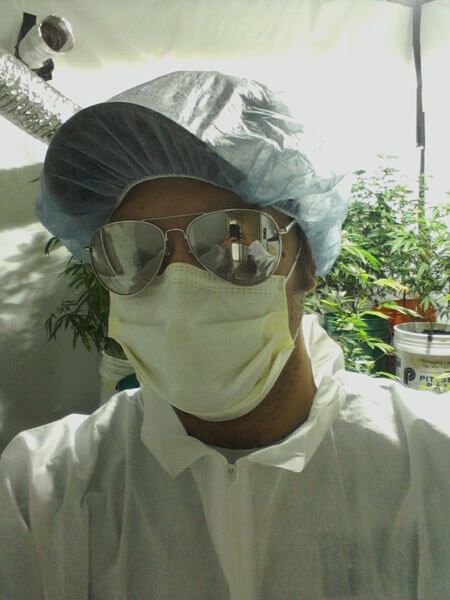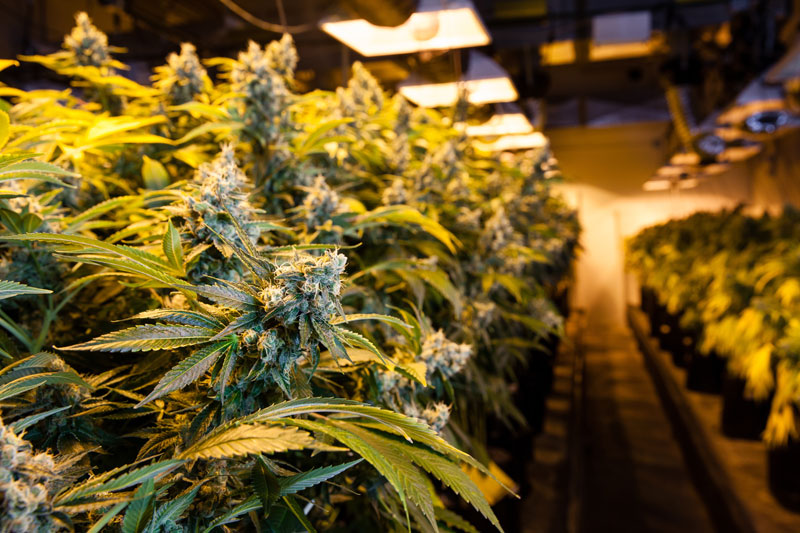Farm Confessional: From Pot Smoker to Pot Farmer
How a recreational marijuana smoker and grower turned his hobby into a legal – and lucrative – business.
I remember scoffing at that estimate since I was in the best physical condition I’d ever been prior to my injury. I signed up for sprint triathlons, half marathons, and all kinds of other physical outdoor activities. I even subbed in as a yoga instructor at times. I felt the estimate put forth by my surgeon to be tantamount to lunacy.
Fast-forward eight years, and I’m still experiencing considerate chronic pain sometimes and moderate pain constantly. After my surgery I decided to embark upon an option made legal in my home state of Oregon: medical marijuana.
It’s a hot-button issue to some, but to me it was merely putting a stamp of validity on an activity I already knew probably more about than I should have. (After all, I did go to art school in Seattle.) Marijuana was a close ally of mine prior to my injury and continued after. Everyone has a vice: for some it’s cigarettes, others alcohol, gambling, gaming, a mix of some or way too much of another. Weed was my thing. Sure, I enjoy decent microbrews, fine Canadian-style whiskey, and top-shelf tequila, but there’s always been the green.
I’d dabbled in growing small amounts in my seasonal gardens; some seasons I’d produce enough for a month or so, and others I managed to grow quite a bit more. In 1998, thanks to the passing of Ballot Measure 67, it became legal to grow, possess, and distribute medical marijuana in Oregon. In 2009, I decided to up the ante on my personal growing game.
At the time I enrolled into the Oregon Medical Marijuana Program (OMMP), there were only a handful of legal dispensaries in the Portland metro area. Under the new laws, I was allowed to grow six plants; six budding plants. Marijuana has two main stages: the vegetative cycle and the flower cycle. Budding (the most marketable part of the plant, once dried and cured) occurs during flowering, and nearly all of the actual growth of the plant is done during the vegetative cycle.
When Ballot Measure 67 was first enacted you were allowed up to 99 non-budding plants. This was later reduced dramatically to 24 after 2010’s passing of Ballot Measure 74 – which lessened the complications of opening up a medical dispensary, as well as changed stipulations in regards to the grower. But regardless, my ability to grow was now sanctioned at the state level and in apparent abundance!
And grow I did, indeed. I teamed up with a buddy who has a degree in pharmaceutical chemistry, and we worked out the confusing calculations of nutrient solutions, soil mixtures, and additives, resulting in a unique concoction of grow mediums and fertilization. It flourished. Now I consistently have 12 plants every flowering cycle and 24 in the vegetative cycle. I distribute locally where I live along the Oregon coast at medical dispensaries, as well as recreational dispensaries, thanks to 2014’s Ballot Measure 91, which made possession of less than an ounce legal for recreational users.

All medicinal growers go through myriad learning curves (as all farmers do), including spider-mite infestations, midges, root aphids, white powdery mildew, caterpillars, pH lockout, nitrogen deficiency, potassium deficiency, grey mold – the list goes on and on. I’ve employed nearly as many methods to combat each problem over time; mail-ordered ladybugs, NEEM oil foliar spray, fumed sulfur, and in some cases even soil-based chemical pesticides. A lesson I’ve learned though, after all of this trial-and-error, is that if you’re employing a perpetual grow (a system of staggered grow times split between two separate light cycles) it maximizes productivity.
It’s an odd feeling to know that I’m not only growing weed, but I’m also reaping financial rewards to pay bills and generally live off of.
It’s an odd feeling to know that I’m not only growing weed, but I’m also reaping financial rewards to pay bills and generally live off of, which I’m proud of since the price of legal marijuana is roughly 50 percent what it is on the black market. What first started off as a hobby has turned into my primary source of consistent income. When I first began to grow, I didn’t want to rely on its generated income – but fast forward a few years, and I’m growing, cultivating, curing, and distributing medicinal marijuana. At the age of 26, I became completely self sufficient, and now at 34, I still am.
The market for medical marijuana is quickly changing here in Oregon and elsewhere as more states, and other countries as well, examine the cost benefits of marijuana incarceration. Washington and Colorado alone brought in roughly $200 million in revenue in their first year of marijuana tax collection. (Specifically $117 million in Colorado and $83 million in Washington.) To say it is not a boon industry is to ignore the obvious fact in recent years people, many of them ill, have found the effects of marijuana favorable.
As for me and my back, well, even high-quality medicinal weed can’t eclipse some pain, but it does help take my mind off of how uncomfortable it can be – and that’s a lot for something I can easily grow and cultivate myself. I am elated to see the public perception change. It’s progress that truly needed to be made.
Follow us

This work is licensed under a Creative Commons Attribution-NoDerivatives 4.0 International License.
Want to republish a Modern Farmer story?
We are happy for Modern Farmer stories to be shared, and encourage you to republish our articles for your audience. When doing so, we ask that you follow these guidelines:
Please credit us and our writers
For the author byline, please use “Author Name, Modern Farmer.” At the top of our stories, if on the web, please include this text and link: “This story was originally published by Modern Farmer.”
Please make sure to include a link back to either our home page or the article URL.
At the bottom of the story, please include the following text:
“Modern Farmer is a nonprofit initiative dedicated to raising awareness and catalyzing action at the intersection of food, agriculture, and society. Read more at <link>Modern Farmer</link>.”
Use our widget
We’d like to be able to track our stories, so we ask that if you republish our content, you do so using our widget (located on the left hand side of the article). The HTML code has a built-in tracker that tells us the data and domain where the story was published, as well as view counts.
Check the image requirements
It’s your responsibility to confirm you're licensed to republish images in our articles. Some images, such as those from commercial providers, don't allow their images to be republished without permission or payment. Copyright terms are generally listed in the image caption and attribution. You are welcome to omit our images or substitute with your own. Charts and interactive graphics follow the same rules.
Don’t change too much. Or, ask us first.
Articles must be republished in their entirety. It’s okay to change references to time (“today” to “yesterday”) or location (“Iowa City, IA” to “here”). But please keep everything else the same.
If you feel strongly that a more material edit needs to be made, get in touch with us at [email protected]. We’re happy to discuss it with the original author, but we must have prior approval for changes before publication.
Special cases
Extracts. You may run the first few lines or paragraphs of the article and then say: “Read the full article at Modern Farmer” with a link back to the original article.
Quotes. You may quote authors provided you include a link back to the article URL.
Translations. These require writer approval. To inquire about translation of a Modern Farmer article, contact us at [email protected]
Signed consent / copyright release forms. These are not required, provided you are following these guidelines.
Print. Articles can be republished in print under these same rules, with the exception that you do not need to include the links.
Tag us
When sharing the story on social media, please tag us using the following: - Twitter (@ModFarm) - Facebook (@ModernFarmerMedia) - Instagram (@modfarm)
Use our content respectfully
Modern Farmer is a nonprofit and as such we share our content for free and in good faith in order to reach new audiences. Respectfully,
No selling ads against our stories. It’s okay to put our stories on pages with ads.
Don’t republish our material wholesale, or automatically; you need to select stories to be republished individually.
You have no rights to sell, license, syndicate, or otherwise represent yourself as the authorized owner of our material to any third parties. This means that you cannot actively publish or submit our work for syndication to third party platforms or apps like Apple News or Google News. We understand that publishers cannot fully control when certain third parties automatically summarize or crawl content from publishers’ own sites.
Keep in touch
We want to hear from you if you love Modern Farmer content, have a collaboration idea, or anything else to share. As a nonprofit outlet, we work in service of our community and are always open to comments, feedback, and ideas. Contact us at [email protected].by Brian Cameron, Modern Farmer
February 3, 2016
Modern Farmer Weekly
Solutions Hub
Innovations, ideas and inspiration. Actionable solutions for a resilient food system.
ExploreExplore other topics
Share With Us
We want to hear from Modern Farmer readers who have thoughtful commentary, actionable solutions, or helpful ideas to share.
SubmitNecessary cookies are absolutely essential for the website to function properly. This category only includes cookies that ensures basic functionalities and security features of the website. These cookies do not store any personal information.
Any cookies that may not be particularly necessary for the website to function and are used specifically to collect user personal data via analytics, ads, other embedded contents are termed as non-necessary cookies.
